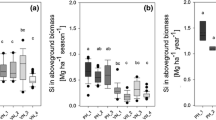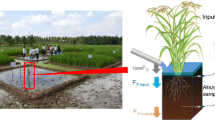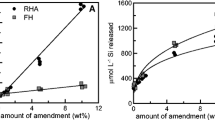Abstract
Background and aims
Silicon (Si) is beneficial for rice plants. It increases their resistance against pests and diseases. Although Si uptake of rice crops is often higher than nitrogen uptake, studies on forms and fluxes of plant-available Si in paddy systems are scarce.
Methods
In 2011/12 we assessed acetate-, oxalate-, and carbonate-extractable Si in topsoil (i.e., Si forms that contribute to the pool of ‘readily soluble Si’) and related them to plant-Si-uptake (n = 10 paddies; Laguna region; Philippines). In the wet season 2013, we determined changes in (i) plant-Si-uptake, (ii) dissolved Si (dSi) and (iii) acetate-extractable Si in topsoils in a high temporal resolution (n = 5 paddies, every ~10 days), and assessed dSi fluxes via irrigation, rain, drainage and percolation (n = 3 paddies).
Results
Si storage in plants at harvest was 0.73 ± 0.12 Mg ha−1 (>78 % in straw), and not related to different Si forms in topsoils. Large stocks of carbonate-extractable Si (2–29 Mg ha−1) suggest an accumulation of ‘phytoliths’ (amorphous Si oxides in straw) in topsoil due to irrigation. Acetate-extractable Si in topsoils hardly changed during plant growth, suggesting dSi and absorded Si was continuously contributed by irrigation and phytolith dissolution.
Conclusions
Geo-/pedologic conditions, irrigation, and straw management are major determinants on Si storage and fluxes in irrigated rice paddies.





Similar content being viewed by others
References
Alvarez J, Datnoff LE (2001) The economic potential of silicon for integrated management and sustainable rice production. Crop Prot 20:43–48
Barbosa-Filho MP, Snyder GH, Elliott CL, Datnoff LE (2001) Evaluation of soil test procedures for determining plant-available silicon. Commun Soil Sci Plant Anal 32:1779–1792
Bartoli F, Wilding LP (1980) Dissolution of biogenic opal as a function of its physical and chemical properties. Soil Sci Soc Am J 44:873–878
Belder P, Bouman BAM, Cabangon R, Quilang EJP, Yuanhua L, Spietz JHJ, Tuong TP (2004) Effect of water-saving irrigation on rice yield and water use in typical lowland conditions in Asia. Agric Water Manag 65:193–210
Bouman BAM, Lampayan RM, Toung TP (2007) Water management in irrigated rice: coping with water scarcity. International Rice Research Institute, Los Banos
Cornelis J-T, Titeux H, Ranger J, Delvaux B (2011) Identification and distribution of the readily soluble silicon pool in a temperate forest soil below three distinct tree species. Plant Soil 342:369–378
de Lima Rodriguez L, Daroub SH, Rice RW, Snyder GH (2003) Comparison of three soil test methods for estimating plant-available silicon. Commun Soil Sci Plant Anal 34:2059–2071
DeMaster DJ (1981) The supply and accumulation of silica in the marine environments. Geochim Cosmochim Acta 45:1715–1732
Desplanques V, Cary L, Mouret J-C, Trolard F, Bourrié G, Grauby O, Meunier JD (2006) Silicon transfers in a rice field in Camargue (France). J Geochem Explor 88:190–193
Dobermann A, Fairhurst TH (2000) Rice: nutrient disorders and nutrient management. International Rice Research Institute, Los Banos
Deutsches Institut für Normung (2002) Bodenbeschaffenheit - Bestimmung der Partikelgrößenverteilung in Mineralböden - Verfahren mittels Siebung und Sedimentation. ISO 11277:1998 + ISO 11277:1998 Corrigendum 1:2002, Beuth-Verlag, Berlin, Germany
Epstein E (2009) Silicon: its manifold roles in plants. Ann Appl Biol 155:155–160
FAO (2014) FAO training series- simple methods for aquaculture. ftp://ftp.fao.org/fi/CDrom/FAO_training/FAO_training/general/x6705e/Index.htm. Accessed 29 September 2014
Fraysse F, Pokrovsky OS, Schott J, Meunier J-D (2009) Surface chemistry and reactivity of plant phytoliths in aqueous solutions. Chem Geol 258:197–206
Guntzer F, Keller C, Meunier J-D (2012) Benefits of plant silicon for crops: a review. Agron Sustain Dev 32:201–213
Imaizumi K, Yoshida S (1958) Edaphological studies on the silicon supplying power of paddy soils. Bull Natl Inst Agric Sci (Jpn) B 8:261–304
IUSS Working Group WRB (2014) World reference base for soil resources 2014. World Soil Resources Reports No. 106. Food and Agriculture Organization, Rome
Klotzbücher T, Marxen A, Vetterlein D, Schneiker J, Türke M, Sinh NV, Manh NH, Chien HV, Marquez L, Villareal S, Bustamante JV, Jahn R (2014) Plant-available silicon in paddy soils as a key factor for sustainable rice production in Southeast Asia. Basic Appl Ecol. doi:10.1016/j.baae.2014.08.002
Kögel-Knabner I, Amelung W, Cao Z, Fiedler S, Frenzel P, Jahn R, Kalbitz K, Kölbl A, Schloter M (2010) Biogeochemistry of paddy soils. Geoderma 157:1–14
Koning E, Epping E, van Raaphorst W (2002) Determining biogenic silica in marine samples by tracking silicate and aluminium concentrations in alkaline leaching solutions. Aquat Geochem 8:37–67
Liu Z, Zhao Y, Colin C, Siringan FP, Wu Q (2009) Chemical weathering in Luzon, Philippines from clay mineralogy and major element geochemistry of river sediments. Appl Geochem 24:2195–2205
Ma JF, Takahashi E (2002) Soil, fertilizer, and plant silicon research in Japan. Elsevier, Amsterdam
Ma JF, Miyake Y, Takahshi E (2001) Silicon as a beneficial element for crop plants. In: LE Datnoff LE, Snyder GH, Korndörfer GH (eds) Silicon in agriculture. Elsevier, Amsterdam, pp 17–39
Ma JF, Tamai K, Yamaji N, Mitani N, Konishi S, Katsuhara M, Ishiguro M, Murata Y, Yano M (2006) A silicon transporter in rice. Nature 440:688–691
Narayanaswamy C, Prakash NB (2010) Evaluation of selected extractants for plant-available silicon in rice soils of Southern India. Commun Soil Sci Plan 41:977–989
Peel MC, Finlayson BL, McMahon TA (2007) Updated world map of the Köppen-Geiger climate classification. Hydrol Earth Syst Sci Discuss 4:439–473
Saccone L, Conley DJ, Koning E, Sauer D, Sommer M, Kaczorek D, Blecker SW, Kelly EF (2007) Assessing the extraction and quantification of amorphous silica in soils of forest and grassland ecosystems. Eur J Soil Sci 6:1446–1459
Sauer D, Saccone L, Conley DJ, Herrmann L, Sommer M (2006) Review of methologies for extracting plant-available and amorphous Si from soils and aquatic sediments. Biogeochemistry 80:89–108
Schwertmann U (1964) Differenzierung der Eisenoxide des Bodens durch Extraktion mit Ammoniumoxalat-Lösung. Z Pflanzenernahr Dung Bodenkd 105:194–202
Seyfferth AL, Kocar BD, Lee JA, Fendorf S (2013) Seasonal dynamics of dissolved silicon in a rice cropping system after straw incorporation. Geochim Cosmochim Acta 123:120–133
Sommer M, Kaczorek D, Kuzyakov Y, Breuer J (2006) Silicon pools and fluxes in soils and landscapes- a review. J Plant Nutr Soil Sci 169:310–329
Struyf E, Damme Van S, Gribsholt B, Middelburg JJ, Meire P (2005) Biogenic silica in tidal freshwater marsh sediments and vegetation (Schelde estuary, Belgium). Mar Ecol Prog Ser 303:51–60
Struyf E, Smis A, Van Damme S, Meire P, Conley DJ (2009) The global biogeochemical silicon cycle. Silicon 1:207–213
Acknowledgments
This work has been partially sponsored by the LEGATO project of the German Ministry for Research and Education (BMBF) and by the Global Rice Science Partnership (management of the IRRI site). We thank Josef Settele for coordinating the LEGATO project. Angelee Fame Ramal managed the IRRI site. Antonio Salamation helped during the paddy work. We thank Alexandra Boritzki, Claudia Hoffmann-Jäniche, Andreas Rämmler, Jutta Fröhlich, Aleksey Prays and Susanne Horka for the help in the laboratory, Sylvia Villareal for the help with the sample transport, and Klaus Kaiser for valuable comments on the manuscript. We furthermore thank the two anonymous reviewers for their helpful comments and suggestions on the manuscript.
Author information
Authors and Affiliations
Corresponding author
Additional information
Responsible Editor: Yong Chao Liang.
Rights and permissions
About this article
Cite this article
Klotzbücher, T., Leuther, F., Marxen, A. et al. Forms and fluxes of potential plant-available silicon in irrigated lowland rice production (Laguna, the Philippines). Plant Soil 393, 177–191 (2015). https://doi.org/10.1007/s11104-015-2480-y
Received:
Accepted:
Published:
Issue Date:
DOI: https://doi.org/10.1007/s11104-015-2480-y




